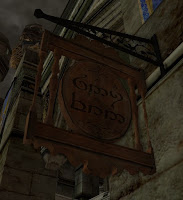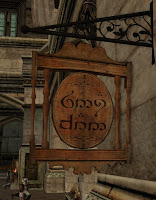That's what you might want as you do your sight-seeing throughout the six Circles of Minas Tirith! As I was traversing the tiers collecting rubbish for certains "urchins," I noticed some beautifully designed signage adorning the streets and alleyways of the White City and I got to wondering what they say. Let's take a closer look, shall we?
The translation of this first one should be pretty obvious since The Merry Swan is a pub you find yourself spending an inordinate amount of time frequenting thanks to the ramblings of Forlong and his chronologically gifted posse. The tengwar here spell out Alph (Swan) [G]Elir (Happy). If the swan is so happy I can only imagine it's because he hasn't yet been conscripted into running errands for Fat Boy Forlong...
Here we have another fairly simple translation. It's common knowledge the name of this tavern is The Mumak and Keep and, sure enough, the writing spells out mumak a barad (tower). If only they were all so simple.
Next we have the sign outside of the Wheel and Cask tavern. This one was rather more difficult because I haven't been able to find a recorded translation for the word "wheel." The sign itself reads Hwinnir a Calph, and I have been able to find the translation for calph is "vessel," so that checks out. "Wheel" doesn't seem to have a matching word in any of the Elvish dictionaries I've examined, but Tolkien was known for using words that sound like what they represented. A good example is lalaith ("laughter"), so perhaps hwinnir is the word for "wheel" after all. It is worth pointing out hwin is the Elvish word for giddiness, or the way you might feel when the world seems to be spinning. -Ir simply indicates the past version of a verb.
Now let's take a look at the signs down in the First Circle. The most obvious element that jumps out at you is they all have the same first word. This word is sennas, which translates as "guesthouse." This first sign reads Sennas Forn, which should be quickly recognizable as "north." Hence, the "northern guesthouse."
Next we have one that was a little harder but still not too difficult. It took me a while to determine what the first letter of the second word was here since not all of the tengwar alphabets out there agree regarding what symbols represent what sounds. However, considering this is the sign outside the Old Guesthouse, it must mean the first letter of the second word is i, because the sign then reads Sennas Iaur, which is "ancient (or old) guesthouse." Ta-da!
This one gave me trouble for a while because, while the sign clearly reads Sennas Charn, I was having a heck of a time finding the translation for the word charn. I finally decided it must be "red," since charn (or, more frequently, carne) could be a reference to the three red blossoms on the tapestries outside this guesthouse. Those blooms are the heraldry of the Lord of Lossarnach, so the Red Guesthouse seems a fitting place for them to stay.
UPDATE: Now that Turbine has added wall plaques to every available surface in Minas Tirith, we now know this sign actually reads "Southern Guesthouse."
Finally, let's look at this nasty bugger. The first word is clearly lond, which should be immediately known to any Tolkien scholar as "haven," "shore," or "narrow pathway." Since the name of the tavern it heralds is called The Haven, this makes perfect sense. The second word, however, has taken me days to puzzle out and delayed the publication of this post for nearly a week. The second half of the second word is clearly -annen, which indicates the past participle variation of the word to which it serves as the suffix. The first half of the word, however, has given me fits. Meri? Veri? Mperi? None of these readings made any sense but, after pouring over multiple Sindarin translators, I've finally decided the first letter must be f, as some tengwar alphabets do indicate for that first symbol (as I mentioned before, not all of them agree on some points). The translation then becomes Lond Pheriannen, which does actually have a meaning: "The Prepared Haven."
I hope you had as much fun reading this as I did trying to figure it all out. If I've erred, please leave a comment to let me know!
Padhric
Master of Toons
A Journal of my Adventures in The Lord of the Rings Online (Follow me on Twitter! @PadhricP)
Sunday, November 8, 2015
Friday, November 6, 2015
A Hiatus from LOTRO
For anyone who actually follows this blog (What in the world is wrong with you? -- Mrs. Pad), you'll notice I have been less than punctual about updating it over the past month or so. Which is like saying, "Gollum doesn't dislike sushi," or "Sauron has some minor control issues."
The thing is, since late September, Real Life had concocted a perfect super-storm Sandy-like scenario involving a prospective new job (which very nearly but ultimately didn't happen), Turbine's perverse and incessant ability to de-motivate people from playing their game (extra points for consistency, I guess), and also some really horrible projectile diarrhea from Chuckie (don't ask). Fortunately, all of these things have finally been resolved and I am back to saving Middle-earth from the forces of darkness once more (Oh, now I can sleep at night. -- Mrs. Pad).
It's certainly encouraging to see Minas Tirith in all of its glorious glory (Hey look! Alliteration and redundancy in a single phrase! You will now be charged double the price of admission). This speaks well to Turbine's new management and commitment to making the game more playable and adding interesting content. This doesn't mean I still don't want to heave Forlong's ample backside off the Pier's Bow or stab to death the next person who uses the word "urchin" in any context, but at least the game has a point again.
Now all we need is some hardware that isn't powered by domesticated rodents.
Cheers,
Padhric
Master of Toons
The thing is, since late September, Real Life had concocted a perfect super-storm Sandy-like scenario involving a prospective new job (which very nearly but ultimately didn't happen), Turbine's perverse and incessant ability to de-motivate people from playing their game (extra points for consistency, I guess), and also some really horrible projectile diarrhea from Chuckie (don't ask). Fortunately, all of these things have finally been resolved and I am back to saving Middle-earth from the forces of darkness once more (Oh, now I can sleep at night. -- Mrs. Pad).
It's certainly encouraging to see Minas Tirith in all of its glorious glory (Hey look! Alliteration and redundancy in a single phrase! You will now be charged double the price of admission). This speaks well to Turbine's new management and commitment to making the game more playable and adding interesting content. This doesn't mean I still don't want to heave Forlong's ample backside off the Pier's Bow or stab to death the next person who uses the word "urchin" in any context, but at least the game has a point again.
Now all we need is some hardware that isn't powered by domesticated rodents.
Cheers,
Padhric
Master of Toons
Subscribe to:
Posts (Atom)






